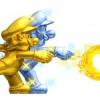On December 23rd 1998, Sonic Adventure — Sonic’s first major 3D outing — was unleashed upon the world. Dreamcast owners centered the Sonic Adventure GD-ROM disc on the consoles’ disc well, closed the lid and hoped that brilliance would follow. Nintendo had proven the platformer could work in three dimensions; now it was Sega’s turn to show that they could do the same.
The game starts with a boss fight that gives the player almost no context. A bad guy appears and the police need help. Something doesn’t sit right with the player almost immediately; there are humans in this world? Guns? The boss fight ends just as quickly as it starts and the camera fades to black.
The next scene opens with a shot of palm trees and a sun-kissed porch. Sonic rests on a deckchair. The player begins to feel that this is a different Sonic from the one we’d grown up with in the 90s. It wasn’t just his appearance and the world that had changed: Sonic was doing the last thing we expected. He was sleeping. Not running, not eating chilli-dogs, but sleeping.
A noise off in the distance stirs Sonic awake. Curious, he glances over in the direction of the sound and is alarmed to find Tails’ plane spiraling out of control before passing out of view and crashing somewhere off-camera. A groggy Sonic forces himself up and staggers out onto the beach. You take control, gathering momentum until you come to a series of wooden walkways. A sudden sharp turn takes you by surprise and you slam straight into the momentum dampening rubber barriers that fence off the edges of the walkways.
You messed up, but thankfully the barriers keep you from flying off into a watery grave. With the brakes placed on you, you’re forced to start building speed again. Ping-ponging awkwardly around on the spot like this was not what the player was looking for in a Sonic game.
In the next scene Sonic runs down a hill at full pelt, hits a speed trap and tunnels his way through one of the series’ most recognizable features; a loop-the-loop. He then lands on a beach where he has to run uphill, through a checkpoint and towards a jump pad, before maneuvering through a series of uphill and downhill sections. By forcing the player through this gauntlet, Sonic Team has taught the player everything they need to know about gaining and losing momentum, the effects of different environment features on speed and how to maneuver in both open and closed spaces. As a reward, this section is topped off with a celebratory double loop-the-loop. Then, out of the corner of your eye you see a killer whale drop into shot like marine confetti.
Now you know all the rules, the training wheels come off. You look ahead of yourself and you see nothing but the familiar; wooden walkways, a checkpoint just like the one you passed earlier, a speed trap and another sharp turn to the right. ‘I’ve got this’, you tell yourself in complete self-assurance; you let yourself get cocky. Nothing seems amiss as you run into the first speed trap. But then, just as you hit it, you realize that you are being propelled way too fast to make the turn. Still, your thumbs try and catch up with your brain; you thumb right on the analogue stick and attempt to steer Sonic around the corner. You expect to move in a smooth curve and are surprised when you find yourself whipped around the corner with a neck-jarring jolt.
As this happens the camera re-aligns to face Sonic head-on. In the nano-second that follows the new camera angle lets you see the situation with clarity. You look back and realize that you didn’t make that turn; it was the second speed trap hidden in that corner that made it for you. You realize you can’t see where you are going any more. And you also realize you’re out of control; being catapulted along on momentum you never wanted. The only thing you can do is deal with the situation.
Your primitive brain gropes for a point of reference to work out how fast you’re moving. ‘Of course! The second speed trap!’. You’ve still got this.
Then just as that nano-second comes to an end, you glance back towards that speed-trap just in time to see the Orca smash into debris before falling back into the ocean. A moment later, you realize that it’s chasing you.
It slams its weight down on the walkways behind you, dragging everything down with it. One pass isn’t enough to satisfy the whale; it makes alternate passes from the left and right to try and catch you. It gets close, really close. Just as it’s nipping on your heels you hit another speed trap.
Fortunately, things look start looking up. The camera moves back around Sonic, letting you get a good grasp on everything around you. You can see the speed traps are thinning out and your artificial momentum is thinning out along with them; control over Sonic has started ebbing back to you. And a jump pad in the distance promises to eject you to safety.
You breathe a sigh of relief as you guide Sonic into the jump pad. But something isn’t right here. Just as you hit the jump pad the camera pans back around in front of Sonic. As the camera moves around you might have just enough time to realize that you never got a good look at where this jump pad was going to land you.
And then you land and you know something isn’t right. You realize what the camera was concealing from you; you’ve escaped from one brittle walkway and landed…onto another brittle walkway. Oh and that whale still looks pretty pissed off.
But there isn’t much you can do about it. More speed traps have juiced you up on life-extending momentum. Your options narrow down to ‘running’ and ‘running really fast’.
You make another blind right turn at the mercy of the speed-traps, are flung into, and ejected off, a jump pad. This time you land on a sandy beach. The camera has returned to normal and you the game has seen fit to relinquish control over Sonic back to you.
You’ve learned some lessons from the ordeal. You realize that somewhere in Japan a videogame developer is laughing because he knows he is like God to you right now; he can give you control, and he can take it away; he doesn’t want you to forget that.
But more importantly, you also learned that when he needs to, this new Sonic can run fast, really fast.
Sonic’s subsequent forays into 3D gaming have been a mixed affair and these days Sonic Adventure feels a little dated; but thinking back, what sticks in the mind is undoubtedly the moment where you’re trying to outrun a giant whale.









